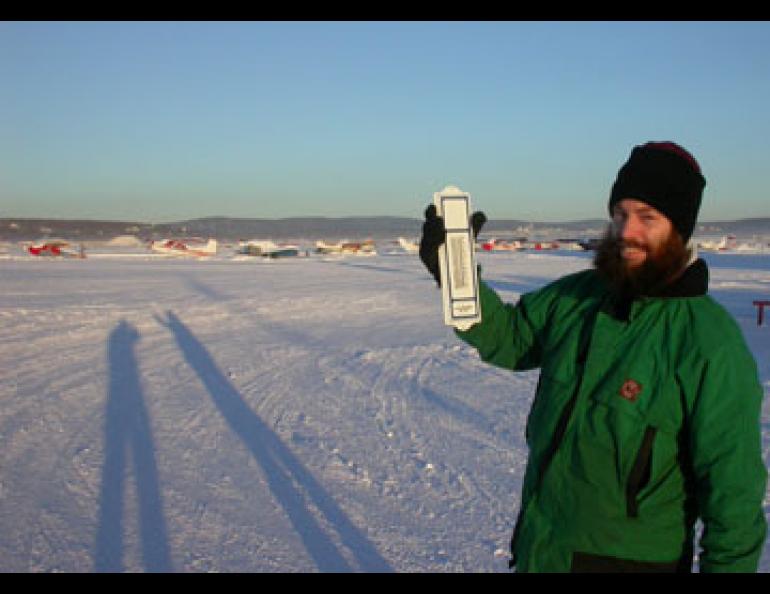
Death of a Temperature Inversion
Fairbanks, Alaska experiences one of the most extreme temperature inversions on the planet. During a temperature inversion, hilltops are warmer than valleys as warm air traps cold air beneath it. To measure this phenomenon—which is caused by short days, low winds, and hills that form walls around a town—I rigged my car with an outdoor thermometer and enlisted Jim Brader to drive me around Fairbanks. Brader is a meteorologist with the National Weather Service Office in Fairbanks.
The digital thermometer attached to my ski rack read minus 28 Fahrenheit when I met Brader at his house near Creamer’s Field in Fairbanks. Creamer’s Field is a low spot in Fairbanks where cold air often pools in both summer and winter.
The temperature rose to minus 21 as Brader drove into the heart of Fairbanks at the corner of Cushman Street and Second Avenue. The rise in temperature might have been due to Fairbanks’ “heat island” effect, Brader said. Warmth leaking from buildings and absorbed by asphalt often makes cities warmer than outlying areas.
As we cruised west down Airport Way, we noticed rising steam from a church smokestack hit an invisible ceiling. The cloud flattened out about 20 feet above our heads.
“It’s a pretty shallow inversion today,” Brader said.
We were seeing the meeting point between a layer of warm air that trapped cold air beneath it and acted like a lid over town. Temperature inversions cause Fairbanks to be one of a few cities nationwide that sometimes have problems with the buildup of carbon monoxide.
“It’s like being in a big garage with all the cars running,” Brader said.
We continued down Airport Way past the Fred Meyer West sign, which won the prize for being the most sensational thermometer with a reading of minus 30 while ours registered minus 22.
We were then ready to check the hills around Fairbanks and measure what we expected to be a great warming. Before we had gained much elevation, we drove through what Brader described as a “notoriously cold spot,” the intersection of Sheep Creek Road and Sheep Creek Extension, near Smith Lake. It was indeed chilly there, at minus 27, and we continued west on Sheep Creek Road, planning to gain some serious elevation by driving up either Ester Dome Road or Murphy Dome Road. That’s when the inversion began disintegrating before our eyes.
We had driven three miles from Smith Lake when the temperature climbed to minus 8 at Black Sheep Lane. By Ann’s Greenhouses, less than one mile later, the temperature was plus 8. We stopped at a pullout near Ann’s and noticed that the spruce trees on the hillsides seemed to be shimmering, a mirage-type effect caused by warm air mixing with cold and wreaking havoc with the light rays reflected from the trees. The first breeze we had felt all morning swept down Goldstream Creek.
We continued on around the Goldstream Valley, the heater in the car suddenly oppressive. The outside temperature held at about plus 6 degrees, even in the lowest parts of the valley. The wind blew snow off trees and onto the windshield.
We returned back to the UAF campus where the wind had yet to take effect. The temperature at the high point of campus roads near the International Arctic Research Center was plus 2. Heading down a hill and descending 100 feet back to Smith Lake, the temperature dropped to minus 20. Seeing the landscape quiver with the same intensity that it had near Ann’s Greenhouses, we parked near Smith Lake and watched the thermometer climb as the wind arrived.
“Wow, we’re starting to pop,” Jim said, looking at the thermometer. We watched it climb five degrees in one minute, after which Jim got out of the car with a handheld thermometer to make sure heat from the car wasn’t tainting our readings.
In 14 minutes, the temperature at Smith Lake rose from 20 below to 6 above. Two things can kill a temperature inversion—wind and solar radiation that heats up the ground and mixes the air—and we had witnessed the former. The wind had obliterated our inversion, Fairbanks had warmed about 30 degrees in an hour, and it was time for lunch.





